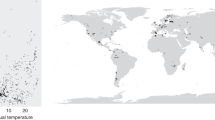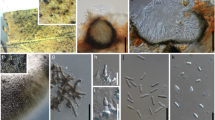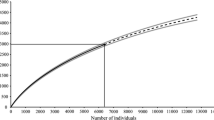Abstract
We conservatively estimate that there is a minimum of 712,000 extant fungal species worldwide, but we recognize that the actual species richness is likely much higher. This estimate was calculated from the ratio of fungal species to plant species for various ecologically defined groups of fungi in well-studied regions, along with data on each groups’ level of endemism. These calculations were based on information presented in the detailed treatments of the various fungal groups published in this special issue. Our intention was to establish a lower boundary for the number of fungal species worldwide that can be revised upward as more information becomes available. Establishing a lower boundary for fungal diversity is important as current estimates vary widely, hindering the ability to include fungi in discussions of ecology, biodiversity and conservation. Problems inherent in making these estimates, and the impact that additional data on fungal and plant species diversity will have on these estimates are discussed.
Similar content being viewed by others
References
Barron GL (2004) Fungal parasites and predators of rotifers, nematodes, and other invertebrates. In: Mueller GM, Bills GF, Foster MS (eds) Biodiversity of fungi: inventory and monitoring methods. Elsevier Academic Press, San Diego, pp 435–450
Benjamin RK, Blackwell M, Chapela IH, Humber RA, Jones KG, Klepzig KD, Lichtwardt RW, Malloch D, Noda H, Roper RA, Spatafora JW, Weir A (2004) Insect- and other arthropod-associated fungi. In: Mueller GM, Bills GF, Foster MS (eds) Biodiversity of fungi: inventory and monitoring methods. Elsevier Academic Press, San Diego, pp 395–434
Boekhout T (2005) Gut feeling for yeasts. Nature 434:449–451
Cannon PF, Kirk PM, Cooper JA, Hawksworth DL (2001) Microscopic fungi. In: Hawksworth DL (ed) The changing wildlife of Great Britain and Ireland. Taylor and Francis Limited, London, pp 114–125
Feuerer T (2006) Biodiversity of lichens. Biodivers Conserv (this volume)
Flather CH, Wilson KR, Dean DJ, McComb WC (1997) Identifying gaps in conservation networks: of indicators and uncertainty in geographic-based analyses. Ecol Appl 7:531–542
Gams W (2006) Biodiversity of soil-inhabiting fungi. Biodivers Conserv (this volume)
Gill EE, Fast NM (2006) Assessing the microsporidia-fungi relationship: combined phylogenetic analysis of eight genes. Gene 375:103–109
Hawksworth DL (1991) The fungal dimension of biodiversity: magnitude, significance and conservation. Mycol Res 95:641–655
Hawksworth DL (1998) The consequences of plant extinctions for their dependent biotas: an overlooked aspect of conservation science. In: Peng C-I, Lowry II PP (eds) Rare, threatened and endangered floras of Asia and the Pacific rim. Academia Sinica Monograph Series No. 16, Taipei, pp 1–15
Hawksworth DL (2001) The magnitude of fungal diversity: the 1.5 million species estimate revisited. Mycol Res 105:1422–1432
Hawksworth DL (2004) Fungal diversity and its implications for genetic resource collections. Stud Mycol 50:9–18
Hawksworth DL, Mueller GM (2005) Fungal communities: their diversity and distribution. In: Dighton J, White JF, Oudemans P (eds) The fungal community: its organization and role in the ecosystem. CRC Taylor and Francis, New York, pp 27–37
Hawksworth DL, Rossman AY (1997) Where are all the undescribed fungi? Phytopathology 87:888–891
Howard PC, Viskanic P, Davenport TRB, Kigenyi FW, Baltzer M, Dickinson CJ, Lwanga JS, Matthews RA, Bamlford A (1998) Complementarity and the use of indicator groups for reserve selection in Uganda. Nature 394:472–475
Hyde KD (2001) Where are the missing fungi? Does Hong Kong have any answers? Mycol Res 105:1514–1518
Hyde KD, Bussaban B, Paulus B, Crous PW, Lee S, McKenzie EHC, Photita W, Lumyong S (2006) Diversity of saprobic microfungi. Biodivers Conserv (this volume)
Keeling PJ, Fast NM (2002) Microsporidia: biology and evolution of highly reduced intracellular parasites. Annu Rev Microbiol 56:93–116
Kerr JT, Sugar A, Packer L (2000) Indicator taxa, rapid biodiversity assessment and nestedness in an endangered ecosystem. Conserv Biol 14:1726–1734
Kirk PM, Cannon PF, David JC, Stalpers JA (2001) Ainsworth and Bisby’s dictionary of fungi 9th edition. CABI Bioscience, Wallingford, UK
Lawry JD, Diederich P (2003) Lichenicolous fungi: interactions, evolution and biodiversity. Bryologist 106(1):80–120
Lichtwardt RW, Cafaro MJ, White MM (2001) The trichomycetes: fungal associates of arthropods. www.nhm.ku.edu/∼fungi/Monograph/Text/Mono.htm
May RM (1991) A fondness for fungi. Nature 352:475–476
Mueller GM, Bills GF, Foster MS (2004) Biodiversity of fungi: inventory and monitoring methods. Elsevier Academic Press, San Diego
Mueller GM, Schmit JP, Leacock PR, Buyck B, Cifuentes J, Desjardin DE, Halling RE, Hjorstam K, Iturriaga T, Larsson K-H, Lodge DJ, May TW, Minter D, Rajchenberg M, Redhead SA, Ryvarden L, Trappe JM, Watling R, Wu Q-X (2006) Global diversity and distribution of macrofungi. Biodivers Conserv (this volume)
Ødegaard F (2000) How many species of arthropods? Erwin’s estimate revised. Biol J Linnean Soc 71:583–597
Pearson DL, Carroll SS (1998) Global patterns of species richness: spatial models for conservation planning using bioindicator and precipitation data. Conserv Biol 12:809–821
Pirozynski KA (1972) Microfungi of Tanzania. I. Miscellaneous fungi on oil palm; II new hyphomycetes. Mycol Papers 129:1–64
Prendergast JR, Quinn RM, Lawton JH, Eversham BC, Gibbons DW (1993) Rare species, the coincidence of diversity hotspots and conservation strategies. Nature 365:335–337
Schmit JP, Mueller GM, Leacock PR, Mata JL, Wu Q-X, Huang Y-Q (2005) Assessment of tree species richness as a surrogate for macrofungal species richness. Biol Conserv 121:99–110
Shearer CA, Descals E, Kohlmeyer B, Kohlmeyer J, Mavanova L, Padgett D, Porter D, Raja HA, Schmit JP, Thorton HA, Volgmayar H (2006) Fungal biodiversity in aquatic habitats. Biodivers Conserv (this volume)
Sisk TD, Launer AE, Switky KR, Ehrlich PR (1994) Identifying extinction threats. Bioscience 44:592–604
Sipman HJM, Aptroot A (2001) Where are the missing lichens? Mycol Res 105:1433–1439
Suh S-O, McHugh JV, Pollock DD, Blackwell M (2005) The beetle gut: a hyperdiverse source of novel yeasts. Mycol Res 109:261–265
Weir A, Blackwell M (2004) Fungal biotrophic parasites of insects and other arthropods. In: Vega FE, Blackwell M (eds) Insect–fungal associations: ecology and evolution. Oxford University Press, Oxford, UK
Weir A, Hammond PM (1997) A preliminary assessment of species-richnesss patterns of tropical, beetle-associated laboulbeniales (Ascomycetes). In: Hyde KD (ed) Biodiversity of tropical microfungi. Hong Kong University Press, Hong Kong, pp 121–139
Weir A, Hughes M, White MM, Cafaro MJ, Suh S-O, Blackwell M (2002) Biodiversity of arthropod-associated fungi: what do we know? What can we predict? IMC7 Book of Abstracts, 7th International Mycological Congress, Oslo, p. 35
Acknowledgements
The authors acknowledge the support of the National Science Foundation (DEB 99-81309 for Schmit and DEB-9972027and DEB-0445216 for Mueller). We thank all who contributed data and the many colleagues and students with whom we have discussed the concepts and particulars of this paper.
Author information
Authors and Affiliations
Corresponding author
Rights and permissions
About this article
Cite this article
Schmit, J.P., Mueller, G.M. An estimate of the lower limit of global fungal diversity. Biodivers Conserv 16, 99–111 (2007). https://doi.org/10.1007/s10531-006-9129-3
Received:
Accepted:
Published:
Issue Date:
DOI: https://doi.org/10.1007/s10531-006-9129-3




